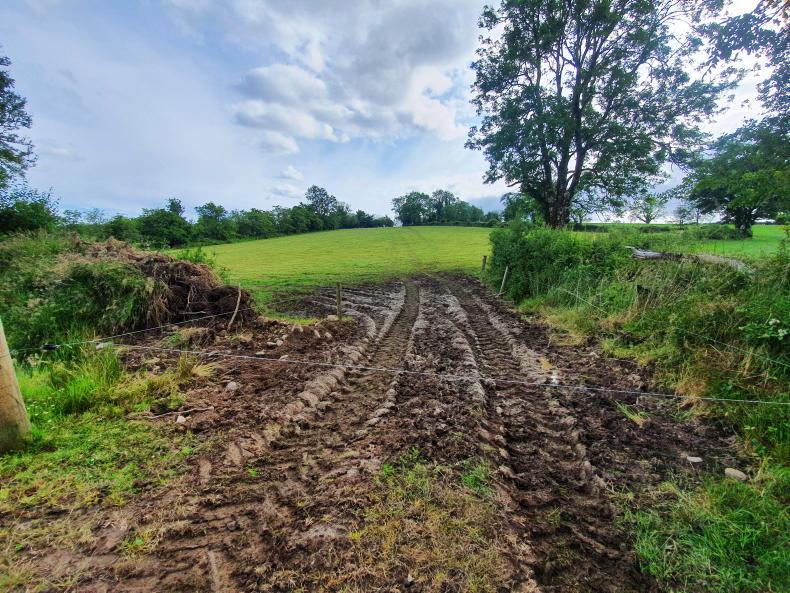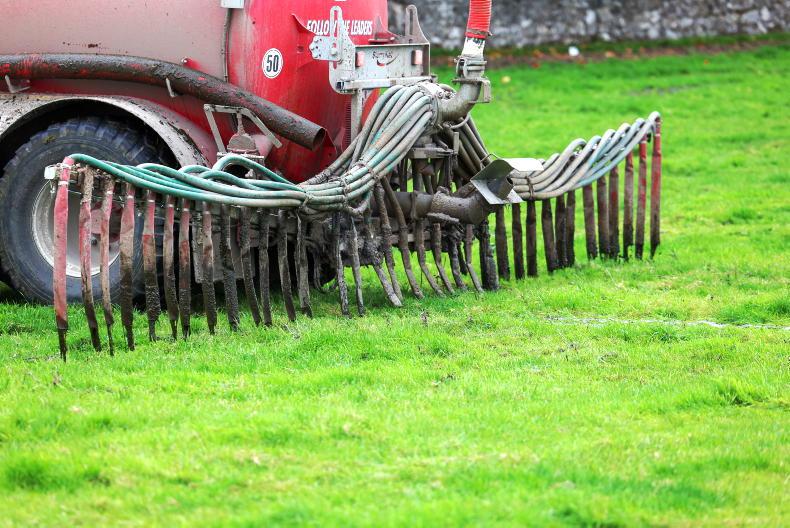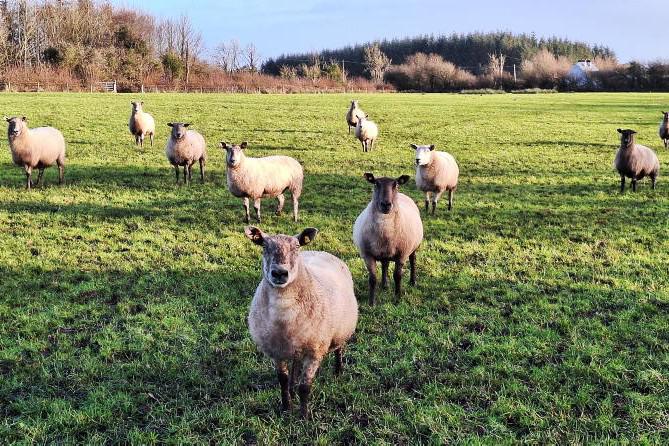Heavy rainfall across the country throughout Thursday and into Friday has seen a rapid deterioration in ground conditions.
The amount of rainfall received and what ground conditions were like prior to Thursday’s rain will determine the best approach for grazing over the coming days.
Here, we outline some tips for dealing with poor ground conditions.
Rehousing for a short period
With over 30mm of rain being reported in some areas over the course of Thursday and Thursday night, rehousing for a short period may be the only and best option.
This will be the case in areas where ground conditions were already quite difficult or on farms where grass is in short supply.
The weather forecast remains wet throughout the weekend and into early next week, meaning there will be little improvement in ground conditions over the coming days.
There is no point doing further damage to ground if it can be avoided.
Silage reserve
Fortunately, there is still at least some reserve of silage sitting in many farmyards at this point and this is the time to use it.
The first stock to be rehoused should be autumn-calving cows.
Where calves are still on the cow, this provides the perfect opportunity to wean autumn-born calves over the coming days.
Calves can be let out to grass for a few hours of the day and rehoused at night.
Yearling cattle should be the next priority to house, as a short period indoors on silage will have only minor effects on the overall thrive of animals.
Concentrates can be offered at a low level where silage quality is poor.
The last group on the farm that should be housed is spring-calving cows that are currently being bred or are within a fortnight of the start of the breeding season.
Rehousing will have a negative effect on the reproductive performance of these animals in the short-term.
Graze driest fields on farm
While they might not be next in the rotation to graze or may not have the most grass on them, if there is an area on the farm that is much drier than the average, it may make sense to move stock to this area of the farm for the weekend.
Keep grass fresh
On many farms, ground conditions will have just become sticky on top while remaining firm below the first two inches.
Where this is the case, keeping stock moving every 24 hours to fresh grass is the best approach.
This minimises the amount of time cattle spend in any one area.

Keep stock moving to fresh grass to minimise damage in paddocks.
While graze-outs may not be as good as you would like, these paddocks can be targeted later in the rotation for a hard grazing or topping is always an option at a later date on a small number of paddocks if needed.
Keeping stock moving to fresh grass every 24 hours will mean reducing the area in which they are grazing
Keeping stock moving to fresh grass every 24 hours will mean reducing the area in which they are grazing.
This may seem counter-productive in periods of bad weather.
However, you will reduce the amount of walking that stock do by reducing their grazing area and if they are getting fresh grass every day, they should be more content and spend more time lying down ruminating.
On lowly stocked farms that can spread out cattle without affecting grass supply over the next few weeks, this may be the solution.
However, for medium and highly stocked farms, this is not an option.
Laneways and hard stands
Where there is access to farm laneways or hard stand areas, these should be used over the next few days.
Cattle can eat up to 70% of their daily intake in four hours grazing and therefore can be kept on farm roadways for some parts of the day to reduce poaching ground.
Graze paddocks to be reseeded
Finally, no matter what actions are taken, doing some damage to ground is almost unavoidable without rehousing stock.
Therefore, where stock are to remain at grass, it may be an option to graze paddocks that have been earmarked for reseeding later this year.
Any damage done to this ground could then be rectified during the reseeding process.
Read more
Variable grass growth rates and deteriorating grazing conditions
Beef Management: grass shortages and thinking about dosing
Thrive: unsettled weather tough on calves
Heavy rainfall across the country throughout Thursday and into Friday has seen a rapid deterioration in ground conditions.
The amount of rainfall received and what ground conditions were like prior to Thursday’s rain will determine the best approach for grazing over the coming days.
Here, we outline some tips for dealing with poor ground conditions.
Rehousing for a short period
With over 30mm of rain being reported in some areas over the course of Thursday and Thursday night, rehousing for a short period may be the only and best option.
This will be the case in areas where ground conditions were already quite difficult or on farms where grass is in short supply.
The weather forecast remains wet throughout the weekend and into early next week, meaning there will be little improvement in ground conditions over the coming days.
There is no point doing further damage to ground if it can be avoided.
Silage reserve
Fortunately, there is still at least some reserve of silage sitting in many farmyards at this point and this is the time to use it.
The first stock to be rehoused should be autumn-calving cows.
Where calves are still on the cow, this provides the perfect opportunity to wean autumn-born calves over the coming days.
Calves can be let out to grass for a few hours of the day and rehoused at night.
Yearling cattle should be the next priority to house, as a short period indoors on silage will have only minor effects on the overall thrive of animals.
Concentrates can be offered at a low level where silage quality is poor.
The last group on the farm that should be housed is spring-calving cows that are currently being bred or are within a fortnight of the start of the breeding season.
Rehousing will have a negative effect on the reproductive performance of these animals in the short-term.
Graze driest fields on farm
While they might not be next in the rotation to graze or may not have the most grass on them, if there is an area on the farm that is much drier than the average, it may make sense to move stock to this area of the farm for the weekend.
Keep grass fresh
On many farms, ground conditions will have just become sticky on top while remaining firm below the first two inches.
Where this is the case, keeping stock moving every 24 hours to fresh grass is the best approach.
This minimises the amount of time cattle spend in any one area.

Keep stock moving to fresh grass to minimise damage in paddocks.
While graze-outs may not be as good as you would like, these paddocks can be targeted later in the rotation for a hard grazing or topping is always an option at a later date on a small number of paddocks if needed.
Keeping stock moving to fresh grass every 24 hours will mean reducing the area in which they are grazing
Keeping stock moving to fresh grass every 24 hours will mean reducing the area in which they are grazing.
This may seem counter-productive in periods of bad weather.
However, you will reduce the amount of walking that stock do by reducing their grazing area and if they are getting fresh grass every day, they should be more content and spend more time lying down ruminating.
On lowly stocked farms that can spread out cattle without affecting grass supply over the next few weeks, this may be the solution.
However, for medium and highly stocked farms, this is not an option.
Laneways and hard stands
Where there is access to farm laneways or hard stand areas, these should be used over the next few days.
Cattle can eat up to 70% of their daily intake in four hours grazing and therefore can be kept on farm roadways for some parts of the day to reduce poaching ground.
Graze paddocks to be reseeded
Finally, no matter what actions are taken, doing some damage to ground is almost unavoidable without rehousing stock.
Therefore, where stock are to remain at grass, it may be an option to graze paddocks that have been earmarked for reseeding later this year.
Any damage done to this ground could then be rectified during the reseeding process.
Read more
Variable grass growth rates and deteriorating grazing conditions
Beef Management: grass shortages and thinking about dosing
Thrive: unsettled weather tough on calves











SHARING OPTIONS